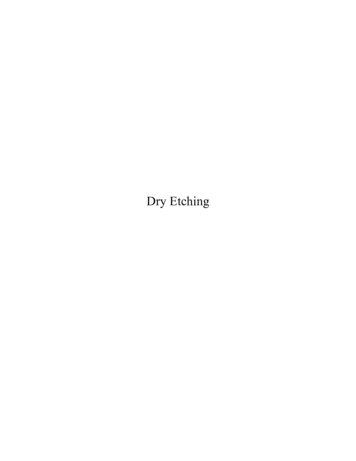Wet Isotropic And Anisotropic Etching
Wet Isotropic andAnisotropic EtchingDennis Kim & Scott KubarykFall 2007ENEE 416
Introduction Wet Silicon Etching Anisotropic Isotropic
Wet Silicon Etching Process FlowTransport ofetchant to surfaceof waferChemical reactionproducing solublebyproductsTransport ofproducts awayfrom the wafer
Anisotropic Etching Orientation Dependent Miller indices become very importantEtch rates differ for different index planes KOH etches 54.74 in respect to 100 http://en.wikipedia.org/wiki/Etching (microfabrication) [3]
Anisotropic Etching – Etchants KOH (Potassium Hydroxide) Etch rates of 1-2µm/min [2]Low Cost – Widely Available Simple equipment (Hotplate and Stir)Corrosive – Strongly Basic (pH 12-14)Not compatible for CMOS fabricationOther Alkali Metals May Be Used Na (Sodium), Cs (Cesium), Rb (Rubidium)[7]
Anisotropic Etching – Etchants EDP (Ethylene Diamine Pyrochatechol) Etch rates of 0.02 – 1µm/minTypically results in Si(OH)4 deposits [1]Higher Equipment CostCorrosive – Carcinogenic – Difficult to DisposeNormally not permitted in fab-lab clean roomsNot compatible for CMOS fabrication
Anisotropic Etching – Etchants TMAH (Tetra Methyl Ammonium Hydroxide) Etch rates of around 1µm/minComparable equipment cost with EDPCompatible with CMOS fabrication No Alkali metals[6]
Why Wet Anisotropic Etching? Low costOrientation Dependant Specific orientations can be etchedControllable etch ratesSmaller and more specific etch patterns
Why Not Wet Anisotropic Etching? ContaminationOrientation Dependent Etch rates varied by temperature andconcentration Must choose wafers carefullyMust closely control these variablesUndercutting still an issue
Etch Rate Dependencies (KOH)[5][4]
Anisotropic Etching - Applications Radiation hardened circuitsJ-FET arraysSolar cell anti-reflecting surfacesWaveguidesIR detectorsHigh value capacitors
Isotropic Etching - Etchants Hydrofluoric Acid (HF) Used with Silicon DioxideEtch rate depends on concentration 6:1 (H2O to HF) has etch rate of 1200 Å /min10:1, 50:1, and 100:1 also usedExtremely dangerous, hard to detectSiO2 6HF Æ H2 SiF6 2H2O
Isotropic Etching - Etchants Silicon Æ Hydrofluoric Nitric Acidic (HNA)Silicon Nitride Æ Phosphoric Acid (H3PO4) Etch rates for pure Si small Oxidize Si using nitric acid (HNO3)Si HNO3 6HF Æ H2SiF6 HNO2 H2 H2O
Iso-Etch Curves 3 parts acetic acid3 parts 70%HNO34 parts 49% HFEtch rate ofsolution the curvecorrespondingwith intersectionpoint (56 µm/min)
Undercutting in Isotropic Etching A 1 – RL/RvCompletely isotropic etch, A 0 (RL Rv)
Advantages of Isotropic Etching InexpensiveSimpleHighly Selective
Disadvantages of Isotropic Etching DangerousPollutionHigh likelihood of contaminationPoor Repeatability TemperatureConcentration
Applications of Isotropic Etching When high etch rates neededNon-critical tasksLarge geometriesRemoval of work-damaged surfacesRounding of sharp anisotropically etchedcornersStructures and planes on single-crystallattices
References [1] m/PROCESSES/PDF%20FILES/WetEtching.pdf[2] Gregory T. A. Kovacs, Nadim I. Maluf, and Kurt E. Petersen, "Bulk Micromachining of Silicon" Proceedings ofthe IEEE, Vol. 86, No. 8, August 1998[3] http://en.wikipedia.org/wiki/Etching (microfabrication)[4] "BYU Cleanroom - KOH Etching of Silicon Wafers, Silicon Dioxide, and Silicon l[5] "Wet Etch for Microelectronics" Dr. Lynn Fuller http://www.rit.edu/ lffeee/wet etch.pdf[6] http://www.campbellscience.com/product TMAH.html[7] http://en.wikipedia.org/wiki/Potassium hydroxide
Anisotropic Etching – Etchants KOH (Potassium Hydroxide) Etch rates of 1-2µm/min [2] Low Cost – Widely Available Simple equipment (Hotplate and Stir) Corrosive – Strongly Basic (pH 12-14) Not compatible for CMOS fabrication Other Alkali Metals May Be Used Na (Sodium), Cs (Cesium), Rb (Rubidium) [7]
Difference between isotropic and anisotropic etching; (a) Substrate before etching (b) Isotropic etch profile (c) Anisotropic etch profile. 11 Figure. 8. Anisotropic etching of silicon; (a) Silicon substrate before etching (b) Self- limiting stable profile with formation
Plasma Etching Page 2 OUTLINE Introduction Plasma Etching Metrics – Isotropic, Anisotropic, Selectivity, Aspect Ratio, Etch Bias Plasma and Wet Etch Summary The Plasma State - Plasma composition, DC & RF Plasma Plasma Etching Processes - The principle of plasma etching, Etching Si and SiO2 with CF4
Etching is a process of removing material from the substrate’s surface. In general, there are two categories that etching can be divided into dry etching, and wet etching. The focus of this section will be solely on dry etching. Wet etching, a process where the substrate is submerged
etching is usually faster than the rates for many dry etching processes and can easily be changed by varying temperature or the concentration of active species. Wet Etch Synonyms: chemical etching, liquid etching Definition: Wet etching is a material removal process that uses liquid chemicals or etchants to remove materials from a wafer.
Review: GaAs etching overview; wet and dry etching; Ref. (Ashby, C.I.H., 1990a) Review: InP wet chemical etching; with (1) defect or damage revealing etchant table, (2) polishing etchant table, and (3) pattern etchant table; Ref. (Adachi, S., 1990b) Review: wet and dry chemical etching of GaAs; classifies wet etchants as non-electrolyte (those with
Al etching start and thus to diff erent etching depths or times (Fig. 118). The formation of hydrogen in the etching reaction is also problematic for a homogeneous etching result. The constantly produced H 2 bubbles stick to the surface and block the etching process through a sup
higher etching rate. Dry Etching Technologies Plasma etching is dominated by chemical erosion. In this way Si or SiO 2 is etched usually with chlorinated and fl uorinated hydrocarbons isotropic and very material selectively. With sputter etching (ion milling), the material is eroded physically by inert gas ions accelerated on the substrate.
A large difference in the etch rate is there depending on the silicon crystalline plane. When silicon like materials is used, this effect can allow very high anisotropy. The important factor of anisotropy etching includes selectivity, handling and process compatibility and anisotropic. Anisotropic wet























